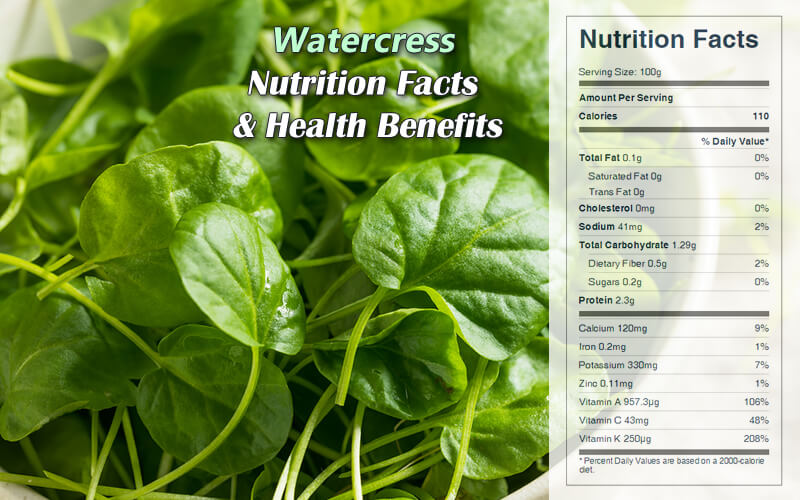Watercress Nutrition Facts & Health Benefits
Watercress is one of the oldest known leaf vegetables consumed by humans. As a cruciferous vegetable, it figures prominently in the diet of anyone at risk of cancer. It is more than 95 percent water and extremely low in calories. Here are the nutritional benefits of watercress.

Nutritional Composition of Watercress
One cup of chopped watercress provides 4 calories, 0.4 g carbohydrate, 0.8 g protein, 0 g fat, 0.6 g dietary fiber, 1598 IU vitamin A, 14 mg vitamin C, 4 mcg folic acid, 112 mg potassium, 14 mg sodium, 20 mg phosphorus, 40 mg calcium, and 8 mg magnesium.
Watercress is 95% water and has low levels of carbohydrates, protein, fat, and dietary fiber. A 100-gram serving of raw watercress provides 11 calories, is particularly rich in vitamin K, and contains significant amounts of vitamin A, vitamin C, riboflavin, vitamin B6, calcium, and manganese.
Watercress Nutrition Facts Label
Health Benefits of Watercress
Watercress is rich in beta-carotene, chlorophyll, folic acid, vitamins A, B6, folic acid, C, and K; the minerals iron, calcium, iodine, and manganese; and beta-carotene and lutein. Watercress leaves, stems, and fruit can be eaten raw. Watercress and many of its relatives, such as garden cress, mustard, radish, and wasabi, are noteworthy for their piquant flavors. Cooking decreases this green's pungency but also decreases its nutritional value.
Watercress belongs to the powerful crucifer family, other members of which are cabbage, broccoli, brussels sprouts, kale, turnips, and radishes. Like them, it should figure prominently in the diet of anyone at risk from cancer. Watercress is also rich in vitamin A and vitamin C, both of which play an important role in combating cancer.
Watercress is related to cabbages and mustard greens and provides some of the same sulfur compounds that have been found to be protective against some forms of cancer and heart disease.
As a cruciferous vegetable, watercress contains isothiocyanates that are partly destroyed by boiling, while the content of carotenoids is slightly increased. These phytochemicals are preserved by steaming or microwave cooking.
Watercress is related to nasturtiums, and both contain potassium and benzyl mustard oil, which research has shown to be powerfully antibiotic. Unlike conventional antibiotics, the substances in watercress and nasturtiums are not only harmless to our intestinal flora, they are positively beneficial to the health of our gut. Urinary and respiratory infections, in particular, benefit from doses of watercress.
Watercress is also a good source of iodine, which is useful for those with low thyroid activity.
Health Risk
Watercress is a semi-aquatic plant and is often grown hydroponically. It can harbor parasites such as liver flukes if collected from contaminated water, so thoroughly washing and soaking watercress in a natural cleansing solution is advisable.
The new tips of watercress leaves can be eaten raw or cooked, although caution should be used when collecting these in the wild because of parasites such as giardia.
By inhibiting the cytochrome P450 enzyme CYP2E1, compounds in watercress may alter drug metabolism in individuals on certain medications such as chlorzoxazone.